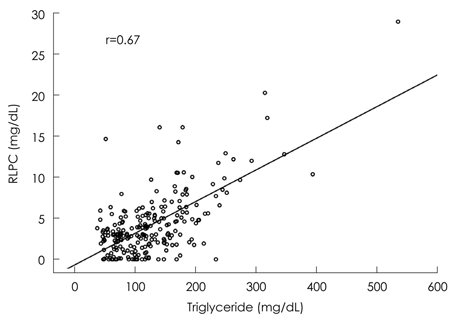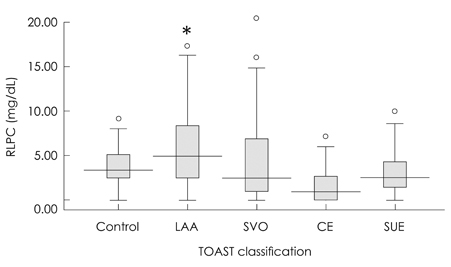J Clin Neurol.
2011 Dec;7(4):203-209. 10.3988/jcn.2011.7.4.203.
High Levels of Remnant Lipoprotein Cholesterol Is a Risk Factor for Large Artery Atherosclerotic Stroke
- Affiliations
-
- 1Department of Neurology and MINER (Molecular Imaging & Neurovascular Research) Laboratory, Dongguk University Ilsan Hospital, Goyang, Korea. dxtxok@gmail.com
- 2Stroke Center, Kwandong University Myongji Hospital, Goyang, Korea.
- 3Department of Radiology, University of Texas M.D. Anderson Cancer Center, Houston, Texas, USA.
- 4Department of Laboratory Medicine, Dongguk University Ilsan Hospital, Goyang, Korea.
- KMID: 2179005
- DOI: http://doi.org/10.3988/jcn.2011.7.4.203
Abstract
- BACKGROUND AND PURPOSE
Remnant lipoproteins (RLPs) are products of partially catabolized chylomicrons and very-low-density lipoprotein, from which some triglycerides have been removed. These particles are smaller and denser than the parent particles and are believed to be strongly atherogenic. We explored the association between RLP cholesterol (RLP-C) and ischemic stroke, including stroke subtypes.
METHODS
A cohort of 142 ischemic stroke patients (90 men and 52 women; age, 65.2+/-12.8 years, mean+/-SD) was enrolled; all had acute infarcts confirmed by diffusion-weighted MRI, and had fasting lipograms. A full stroke-related evaluation was conducted on each patient. An outpatient population of 88 subjects without a history of cerebrovascular or cardiovascular disease served as a control group. Serum RLP fractions were isolated using an immunoaffinity gel containing specific antiapolipoprotein (anti-apo)B-100 and anti-apoA-I antibodies. RLP-C values were considered to be high when they were in the highest quartile of all values in the study.
RESULTS
High RLP-C values were more common in stroke patients than in control patients (31.0% vs. 14.8%, p=0.01), when 5.6 mg/dL (>75th percentile) was used as the cutoff value. Multivariable analyses indicated that RLP-C was a risk factor for stroke, with an odds ratio of 2.54 (p=0.045). The RLP-C level was higher in the large artery atherosclerosis subgroup (5.7+/-3.9 mg/dL) than in any other stroke subgroup (small vessel occlusion, 4.9+/-5.9 mg/dL; cardioembolism, 1.8+/-2.3 mg/dL; stroke of undetermined etiology, 3.1+/-2.9 mg/dL).
CONCLUSIONS
We have found an association between high RLP-C levels and ischemic stroke, and in particular large artery atherosclerotic stroke.
MeSH Terms
Figure
Cited by 1 articles
-
Multimarker Approach in Discriminating Patients with Symptomatic and Asymptomatic Atherosclerotic Carotid Artery Stenosis
Piotr Musialek, Wieslawa Tracz, Lukasz Tekieli, Piotr Pieniazek, Anna Kablak-Ziembicka, Tadeusz Przewlocki, Ewa Stepien, Przemyslaw Kapusta, Rafal Motyl, Jakub Stepniewski, Anetta Undas, Piotr Podolec
J Clin Neurol. 2013;9(3):165-175. doi: 10.3988/jcn.2013.9.3.165.
Reference
-
1. Gotto AM Jr. Evolving concepts of dyslipidemia, atherosclerosis, and cardiovascular disease: the Louis F. Bishop Lecture. J Am Coll Cardiol. 2005. 46:1219–1224.
Article2. Illingworth DR, Durrington PN. Dyslipidemia and atherosclerosis: how much more evidence do we need? Curr Opin Lipidol. 1999. 10:383–386.3. Amarenco P, Labreuche J. Lipid management in the prevention of stroke: review and updated meta-analysis of statins for stroke prevention. Lancet Neurol. 2009. 8:453–463.
Article4. Devaraj S, Vega G, Lange R, Grundy SM, Jialal I. Remnant-like particle cholesterol levels in patients with dysbetalipoproteinemia or coronary artery disease. Am J Med. 1998. 104:445–450.
Article5. Karpe F, Taskinen MR, Nieminen MS, Frick MH, Kesäniemi YA, Pasternack A, et al. Remnant-like lipoprotein particle cholesterol concentration and progression of coronary and vein-graft atherosclerosis in response to gemfibrozil treatment. Atherosclerosis. 2001. 157:181–187.
Article6. Jialal I, Devaraj S. Remnant lipoproteins: measurement and clinical significance. Clin Chem. 2002. 48:217–219.
Article7. Krauss RM. Atherogenicity of triglyceride-rich lipoproteins. Am J Cardiol. 1998. 81:13B–17B.
Article8. Hodis HN. Triglyceride-rich lipoprotein remnant particles and risk of atherosclerosis. Circulation. 1999. 99:2852–2854.
Article9. Cohn JS, Marcoux C, Davignon J. Detection, quantification, and characterization of potentially atherogenic triglyceride-rich remnant lipoproteins. Arterioscler Thromb Vasc Biol. 1999. 19:2474–2486.
Article10. Karpe F, Boquist S, Tang R, Bond GM, de Faire U, Hamsten A. Remnant lipoproteins are related to intima-media thickness of the carotid artery independently of LDL cholesterol and plasma triglycerides. J Lipid Res. 2001. 42:17–21.
Article11. McNamara JR, Shah PK, Nakajima K, Cupples LA, Wilson PW, Ordovas JM, et al. Remnant-like particle (RLP) cholesterol is an independent cardiovascular disease risk factor in women: results from the Framingham Heart Study. Atherosclerosis. 2001. 154:229–236.
Article12. Kugiyama K, Doi H, Takazoe K, Kawano H, Soejima H, Mizuno Y, et al. Remnant lipoprotein levels in fasting serum predict coronary events in patients with coronary artery disease. Circulation. 1999. 99:2858–2860.
Article13. Tanaka A. Postprandial hyperlipidemia and atherosclerosis. J Atheroscler Thromb. 2004. 11:322–329.
Article14. Nakamura T, Obata JE, Takano H, Kawabata K, Sano K, Kobayashi T, et al. High serum levels of remnant lipoproteins predict ischemic stroke in patients with metabolic syndrome and mild carotid atherosclerosis. Atherosclerosis. 2009. 202:234–240.
Article15. Amarenco P, Bogousslavsky J, Caplan LR, Donnan GA, Hennerici MG. Classification of stroke subtypes. Cerebrovasc Dis. 2009. 27:493–501.
Article16. Adams HP Jr, Bendixen BH, Kappelle LJ, Biller J, Love BB, Gordon DL, et al. Classification of subtype of acute ischemic stroke. Definitions for use in a multicenter clinical trial. TOAST. Trial of Org 10172 in Acute Stroke Treatment. Stroke. 1993. 24:35–41.
Article17. Nakajima K, Okazaki M, Tanaka A, Pullinger CR, Wang T, Nakano T, et al. Separation and determination of remnant-like particles in human serum using monoclonal antibodies to apo B-100 and apo A-I. J Clin Ligand Assay. 1997. 19:177–183.18. Kugiyama K, Doi H, Motoyama T, Soejima H, Misumi K, Kawano H, et al. Association of remnant lipoprotein levels with impairment of endothelium-dependent vasomotor function in human coronary arteries. Circulation. 1998. 97:2519–2526.
Article19. Doi H, Kugiyama K, Oka H, Sugiyama S, Ogata N, Koide SI, et al. Remnant lipoproteins induce proatherothrombogenic molecules in endothelial cells through a redox-sensitive mechanism. Circulation. 2000. 102:670–676.
Article20. Griendling KK, Alexander RW. Endothelial control of the cardiovascular system: recent advances. FASEB J. 1996. 10:283–292.
Article21. Fukushima H, Sugiyama S, Honda O, Koide S, Nakamura S, Sakamoto T, et al. Prognostic value of remnant-like lipoprotein particle levels in patients with coronary artery disease and type II diabetes mellitus. J Am Coll Cardiol. 2004. 43:2219–2224.
Article22. Satoh A, Adachi H, Tsuruta M, Hirai Y, Hiratsuka A, Enomoto M, et al. High plasma level of remnant-like particle cholesterol in the metabolic syndrome. Diabetes Care. 2005. 28:2514–2518.
Article23. Cybulsky MI, Gimbrone MA Jr. Endothelial expression of a mononuclear leukocyte adhesion molecule during atherogenesis. Science. 1991. 251:788–791.
Article24. Kim DE, Kim JY, Schellingerhout D, Kim EJ, Kim HK, Lee S, et al. Protease imaging of human atheromata captures molecular information of atherosclerosis, complementing anatomic imaging. Arterioscler Thromb Vasc Biol. 2010. 30:449–456.
Article25. Ellsworth JL, Kraemer FB, Cooper AD. Transport of beta-very low density lipoproteins and chylomicron remnants by macrophages is mediated by the low density lipoprotein receptor pathway. J Biol Chem. 1987. 262:2316–2325.
Article
- Full Text Links
- Actions
-
Cited
- CITED
-
- Close
- Share
- Similar articles
-
- Drug treatment of dyslipidemia
- Residual Cardiovascular Risk Remains Despite of Statin Treatment: Importance of High-Density Lipoprotein Cholesterol
- Triglyceride-Rich Lipoproteins and Remnant Cholesterol in Cardiovascular Disease
- Role of Blood Lipid Levels and Lipid-Lowering Therapy in Stroke Patients with Different Levels of Cerebral Artery Diseases: Reconsidering Recent Stroke Guidelines
- Risk Factor and Prevention of Coronary Artery Disease



